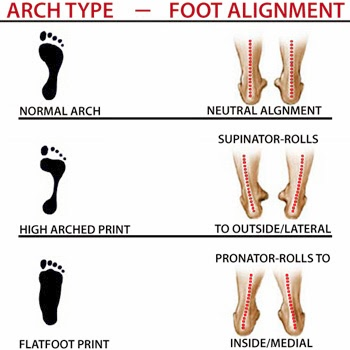Author: Bryan Lang, PT, DPT, MHA, CSCS, Cert.DN: Doctor of Physical Therapy, Business Owner, Associate Professor, and Blog Contributor. Explores common client questions, helps find solutions for every day functional health concerns, and interprets difficult theories in healthcare rehabilitation. Committed to life-long learning and education. Learn more about Bryan on Google+.
Running shoes are extremely important not only for foot comfort, but also for the prevention of low back, hip and knee pain that occur far too often. If you haven’t experienced pain with running yet, great job! This article will tell you how to find shoes that will keep you this way. If you are one of the reported 20-75% of runners who report experiencing new pain because of running, this article will help you avoid future pain and help address some of the ailments you are experiencing.
Starting with the basics:
Guess who knows the most about your body…You! With shoes, you need to listen to your body and pay attention to some structural aspects of your body in order to choose the perfect shoe for you. Here are a few questions that you should answer before you try any shoes on:
1. How will my weight affect my running?
Running is a great way to get in shape and to stay in shape. However, many runners who are trying to start to lose weight stop because they start to develop pain. Increased body mass increases the load on your hips, knees, and feet. It also shifts your center of mass forward and that can cause low back pain as your spine attempts to stay upright. You should know how your body mass index (BMI) compares to the general population. It will give you a very rough idea of if your weight is normal, underweight or overweight. In order to do this, simply plug your height and weight into the website below.
http://www.thecalculatorsite.com/health/bmicalculator.php
You should get something that looks like this:
As a physical therapist, I don’t always take this information at complete face value. If you are an avid body builder, the test will show you as overweight because you have more muscle. However, it does let you know that according to the population you are carrying more weight on your frame than others and that can affect how your body will tolerate running.
2. How high is my arch?
There are two simple ways to identify what type of arch your foot has. The first is to stand on a piece of paper and then have a friend trace the boarder of your foot. Make sure that they trace the inside of your arch, too.
Alternatively, you can fill up a bucket with water and buy a blue piece of paper. Dip your foot into the water, then pull it out and let the extra drips fall off back into the bucket. Then, stand on the blue piece of paper. The water will create an imprint on the paper of your foot arch structure.
3. How do I walk/run?
There are 3 main foot positions that people bias themselves into when they walk. They are pronation, supination, and a neutral foot position.
Pronation is when the inside arch of your foot flattens too much when you walk/run and, as a result, your foot rolls inward.
Supination is when your foot rolls outwards and the main distribution of your weight is on the outside aspect of your foot.
Neutral foot position is when the weight of your body is distributed evenly through your foot. There is no rolling of the foot inward or outward.
4. How does my foot strike the ground?
Believe it or not, there is a point in running when both feet are not touching the ground. In physical therapy, we call this the “double float phase.” It is important to know how our foot strikes the ground in order to purchase a shoe that will help absorb the impact as effectively as possible. There are three main variations of how our foot lands:
Heel strike: when the heel or back of your foot makes contact with the ground first.
Midfoot Strike: when the middle portion of your foot makes first contact with the ground.
Forefoot Strike: when the front portion of your foot closer to your toe box (the “ball” of the foot) makes first contact with the ground.
You can simply ask someone to watch you run. Tell them to pay specific attention to what part of your foot makes contact with the ground first when you are running.
***Quick tip: most people in the United States tend to start as heel or midfoot strikers.
5. What is my mile pace?
There are so many different ways to do this. If you have a smart phone, you can use an app such as Runkeeper, Map My Run or Runtastic. They will give you your time, distance and average pace per mile.
If you don’t have a smart phone, you can go to your local track with a stopwatch and time how long it takes you to complete one mile of running.
**Quick tip: Keep in mind that your time will be faster for your mile run than if you were running for multiple miles at a time. The best way to determine your true mile time is to run the distance that you plan on running or have been running.
6. What are my goals?
There is a big difference between if you are planning to run 1 mile, 2 days a week versus someone running 8 miles 3 days a week. Knowing how often and how far you want to run will be important for determining your proper shoe. It will also be important so that you know when to get new shoes.
***Quick tip: If you are running on a regular basis, changing your shoes every 3 months is a healthy habit to get into.
Now all you have to do is use the information that you just collected to find the perfect shoe for you. This can take a lot of work and research, but there is a simpler way for those individuals who are running for recreation. Take the information above and plug it into the website below:
http://www.runnersworld.com/shoe-finder/shoe-advisor
The website will provide you with a variety of shoes based on what you placed in the designated boxes.
The next step is to go to a store that specializes in running shoes. Bring the list of recommended shoes from runnersworld.com, but also have their staff assess your walk/run in order to make sure the information you found with your assessments were correct. Then, try on the shoes recommended to you via the website and from the store employees. Make sure you actually go outside and jog with the shoes on. Let your body decide what feels best for your feet.
Taking all of this into consideration for a running shoe may seem extensive, but after you complete the required information, you won't have to go through it all again. Instead, you will just edit some sections as your running style changes. Then, of course, as your change your running style, your shoes will change as well. This will keep a harmonious balance between your feet and the rest of your body as you continue to walk, jog, skip or jump.
Should you have more questions regarding shoe fitting or symptoms you may be experiencing with these activities, contact your physical therapist for clarification – as always, we would be happy to help!





